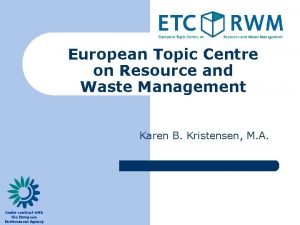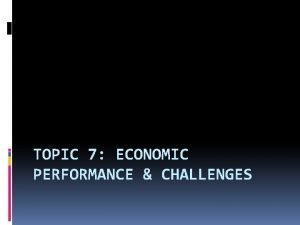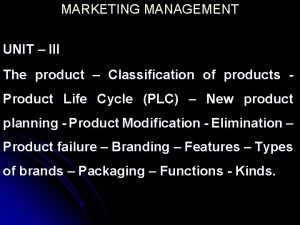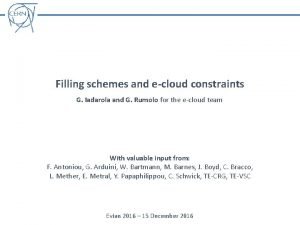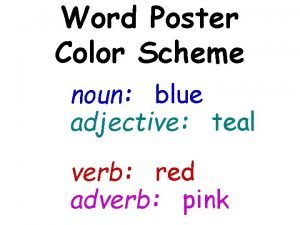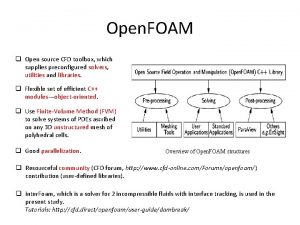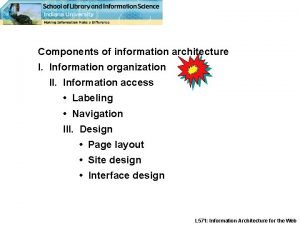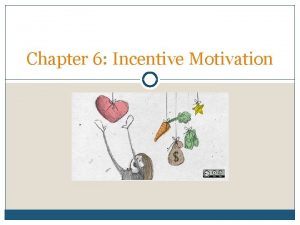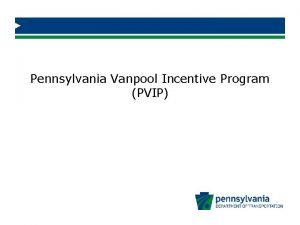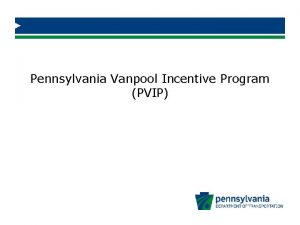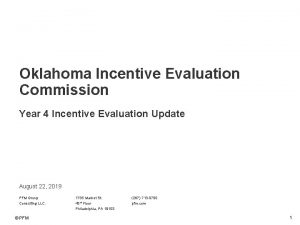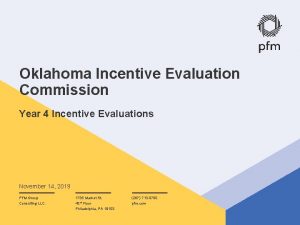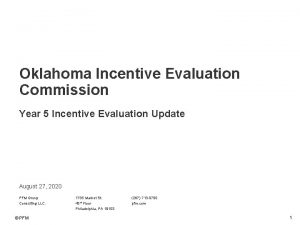Topic Centre WE 2008 Economic incentive schemes for



















- Slides: 19

Topic Centre WE 2008 Economic incentive schemes for OSH prevention in enterprises – Literature survey Workshop, OSHA, Bilbao, 4 th Feb 2009 Dr. Daniela Treutlein (task leader) Economic incentive schemes

Background aim 2 • joint work with task partners S. de Meyer (Prevent), J. Elo. Schäfer (Kooperationsstelle Hamburg), M. Pecillo (CIOP) • initiated and financed by the European Agency for Safety and Health at work (OSHA) • Aim of the study: overview about economic incentive models applied in firms to foster OSH prevention measures Economic incentive schemes

Agenda I. Definition and classification of economic incentives II. Economic incentives for OSH prevention III. Scope of literature search IV. Empirical evidence – literature overview V. Summary of main results VI. Research gaps & criticism VII. Conclusions VIII. Policy recommendations 3 Economic incentive schemes

I Classification of economic incentive schemes Economic incentives (EI) Firm-extern Firm-intern Insurancerelated financial non-financial Governmentbased financial non-financial Definition (OSHA): External economic (financial) benefits to employers to stimulate improvements to workers’ safety and health. 4 Economic incentive schemes

II Economic incentives for OSH prevention • Strong case for EI by European Foundation and ILO (P. Dorman (2000)): • EI are directly linked with business performance (impact on productivity easily visible to managers) • EI can stimulate continuous improvement (vs. regulation specifying minimum performance level) • EI are outcome-oriented and forward-looking, i. e. by nature apply to both, traditional and emerging risks • EI encourage problem-solving and innovation (vs. method -focus) • Wright et al. (2005): manager survey indicates advice and EI best method to stimulate prevention measures (vs. enforcement, reputation risk, bigger fines, more expensive insurance) 5 Economic incentive schemes

III Scope of literature search • Aim: identify recent (~ 2000 -2008) scientific literature in English • Steps taken: • List of relevant search terms (English) • OSH-specific databases: OSH update, Scopus. • Dutch university database Picarta, Dutch OSH-specific database Arbobibliothek. • Google scholar for specific works identified from references • Screening identified literature for relevancy • Develop structure and fill in paragraphs with identified literature • Excel template with summary of each piece of work • Final adaptation of structure 6 Economic incentive schemes

IV Empirical evidence – literature overview 7 Economic incentive schemes

IV Empirical evidence – literature overview 8 Economic incentive schemes

IV Empirical evidence – literature overview 9 Economic incentive schemes

IV Empirical evidence – literature overview 10 Economic incentive schemes

IV Empirical evidence – literature overview Note: Table is work in progress. 11 Economic incentive schemes

V Summary of main results • overly positive evaluation of EI schemes in literature • introduction of regulation: no clear reduction effect on frequency of work-related injuries • enforcement of regulation: specific deterrence yields positive and significantly higher effect on sick-leave than general deterrence • taxes, linking EI to audits/ intervention programs and matching funds are promising approaches with some restrictions • two-step premium assessment possibly even better than manual experience rating of workers’ compensation insurance • firm-intern financial incentive schemes make strong case for EI • employers’ liability insurance may be a good starting point for EI • simple, low-cost solutions, disseminated by personal contact for SMEs 12 Economic incentive schemes

VI Research gaps & criticism • measurement problems, i. e. (uncontrollable) contextual factors, study design and selectivity, temporal sequencing, data limitations ( Tompa et al. 2007, 2008 TNO/SEO 2008) • often unclear and ambiguous effects of OSH regulation/ inspection and EI effectiveness (Paton, 2007) • comparability problem due to differences in definition of incentive schemes, research entity, sample size and methodological approach • need for SME-specific EI and evaluation schemes (Walters 2001) • Lacking data: ØOverview statistics, e. g. number of firms applying EI (national, EU) ØContextual factors, e. g. organizational attitude, sector, size (firm) 13 Economic incentive schemes

VII Conclusions – in a nutshell • combination of EI, advice, enforcement and persuasion is best for businesses • which works best may depend on general attitude of the company towards OSH (Wright et al. 2005): • For convinced: persuasion and incentives • For negative: enforcement • For motivated: advice and support • company attitudes depend on sector and size of company but also on uncontrollable factors • How to effectively approach a larger number of SMEs? Ø Financial limitations, employee defensiveness, language differences and low literacy, reliance on external support 14 Economic incentive schemes

VIII Policy recommendations • Cash benefits in form of workers’ compensation are not enough ( increasing claim frequency) • Any legal regulation should be accompanied by incentives/ sanctions to make them effective • Taxes are effective, but restrictive in application • Experience-rating and two-step premium assessment rating schemes show promising evaluation results • Firm-intern EI proven particularly creative and successful and worthwhile to test and implement more widely • SME-specific research and EI development is needed • Overview statistics are needed 15 Economic incentive schemes

Generalization and comparability of scientific results need improvement but at the same time case-specific applications for businesses (‘maatwerk’) are needed! More interdisciplinary approaches between OSH experts and economists/ econometricians are needed! 16 Economic incentive schemes

ADD UP: Design of EI schemes 1. Attention to 3 key aspects for the implementation of EI (Munich. Re 2005): • Reliability of the workers’ compensation system • Technical and social/ political feasibility of EI • Weakening of credibility of workers’ compensation system by too many changes of EI system in a short time period 2. Accounting for SME-specific problems: • develop networks of SMEs (Mose & Karqvist 2004) • holistic and integrative approach incl. workers and management (Lippin et al. 2000) • trust-based dialogue between OSH consultants and SME owners (Eakin et al. 2000) 3. Consideration of moral hazards • Claims-reporting moral hazard • Risk-bearing moral hazard 17 Economic incentive schemes

ADD UP: Applied evaluation methods – literature • Effect indicators frequently used in the literature: • costs of absenteeism, staff turnover, true production costs (including costs of accidents and illnesses) • frequency of injuries, industry aggregate accident rates • frequency/ severity of claims • consumer satisfaction, employee motivation, etc. • Durbin et al. (1998): strongest research on experience rating of workers’ compensation does not use insurance claims or insurance costs to measure OSH effect but • benefit-firm size interaction • natural experiments • fatality rates • Tompa et al. (2006, 2008): • evaluation often introduced too late and in secondary manner • interdisciplinary approaches needed (e. g. econometricians, OSH experts) 18 Economic incentive schemes

ADD UP: Applied evaluation methods – TNO examples • Diverse monitoring and evaluation tools (e. g. periodic “Monitor Arbeidsongevallen”) • Handbook “Effectiveness measurement of labor market policy at the individual level” (TNO/ SEO) • Cost-benefit analysis of e. g. workplace health investments in companies (made-to-measure approach) • Labor productivity measurement and business applications (interactive approach) 19 Economic incentive schemes
 2008 2008
2008 2008 Third person example
Third person example Narrowing down a topic exercises
Narrowing down a topic exercises European topic centre
European topic centre Weight center
Weight center Differentiate between centre of mass and centre of gravity
Differentiate between centre of mass and centre of gravity Free enterprise system def
Free enterprise system def Topic 7 economic performance and challenges
Topic 7 economic performance and challenges Chapter 1 lesson 2 our economic choices worksheet answers
Chapter 1 lesson 2 our economic choices worksheet answers Economic growth vs economic development
Economic growth vs economic development Difference between economic growth and economic development
Difference between economic growth and economic development Product classification schemes
Product classification schemes Filling schemes
Filling schemes Wecs schemes
Wecs schemes Packaging color schemes
Packaging color schemes Blue adjective
Blue adjective Swak4foam
Swak4foam What are poem elements
What are poem elements What is rhyme scheme
What is rhyme scheme Components of information architecture
Components of information architecture



